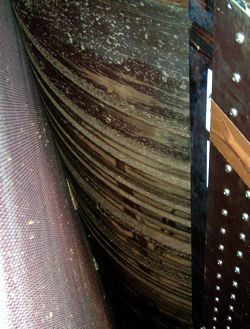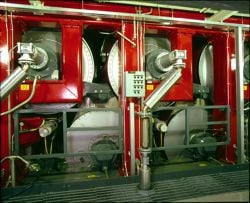Dryer service case study – setting up a baby dryer doctor
Jul 5, 2022
This article is a review of a service call made at a southern U.S.A. linerboard mill to diagnose and adjust their baby dryer doctor. This case study includes not only the specific findings and corrective actions taken, but goes further to cover future recommendations and follow-up. (This is just one example of several drying section services offered by Valmet.)
Case study

The Valmet service engineer's initial inspection determined that the load pressure was set at 30 psi. The blade angle was 27 degrees at the tending side and 26 degrees at the drive side and the blade was partially worn. The baby dryer surface was streaked with areas with stock buildup and other areas cleaned to bare metal. This is an indication of uneven dryer surface wear (see photo). The original doctor blade shows uneven wear patterns. This is also an indication of uneven dryer surface wear.
Actions taken
After making an initial inspection and noting the uneven wear on the dryer, the Valmet engineer then addressed specific problems, including the following items:
- The doctor mounting brackets were adjusted until an adequate 29-30 degree angle was achieved. (30 degrees tending side, 29 degrees drive side and level to the roll to within 0.3 degrees)
- The turnbuckles were adjusted. Some repair work was required on the tending side turnbuckle. The threads on both ends of the turnbuckle were in poor condition and still did not function properly.
- The baby dryer was hand cleaned using Scotch-Brite pads and mineral spirits after the setup work was complete.
- A monel blade was installed to check for 100 percent blade contact. There were areas that the blade did not contact the roll and a 0.005 inch feeler gauge would go by the blade. This was checked with 10 PSI load pressure. (This is another indication of uneven dryer surface wear.)
- The doctor and dryer operated with a bronze blade for approximately 2 hours before startup. This was done to condition the dryer surface, which should have been done during the original dryer installation.
- The machine was started up with the bronze blade installed. Mill production personnel requested that the bronze blade remain in for startup doctoring difficulties with a bronze blade in the past.
- The loading pressure was set to 25 PSI after setup was complete and remained at 25 PSI during startup.
- The doctor was successful at removing the sheet during dry-end threading.
Recommendations
Based on the inspections completed during the visit, the Valmet engineer made the following recommendations.
- Clean the doctor and blade before every machine tail threading. Paper and paper dust tend to hang up and collect on the doctor blade when doctoring the sheet from the baby dryer. This debris, if allowed to build up, will reduce blade contact pressure and reduce the doctor’s ability to remove the sheet.
- Clean the baby dryer surface during regular maintenance outages. A build up of starch and paper residue covered parts of the dryer. A periodic cleaning of the dryer surface could improve the doctor’s ability to remove the sheet.
- Check the baby dryer surface temperature and compare it to sheet temperature. A high temperature differential can cause the sheet to stick to the dryer and make release difficult.
- Cover the dryer with Valmet coating designed to release the sheet. This coating will reduce the energy required for the doctor to remove the sheet. First have Valmet experts inspect the dryer can to determine if regrinding would be required.
- Replace the tending side turnbuckle. The existing unit has damaged threads and is difficult to adjust. Be careful not to affect the current doctor setup.
Dryer services from Valmet

In addition, Valmet offers a full line of spare and wear parts for your Valmet, Metso or Beloit dryers, and other manufacturer’s dryers, including: doctor blades and loading tubes, doctor holders, steamfits, syphons, maintenance kits, bearing assemblies, enclosed gearing, expansion joint seals, dryer head spares and many others.
Contact your Valmet representative to learn more about maintaining your drying section and optimizing dryer performance.